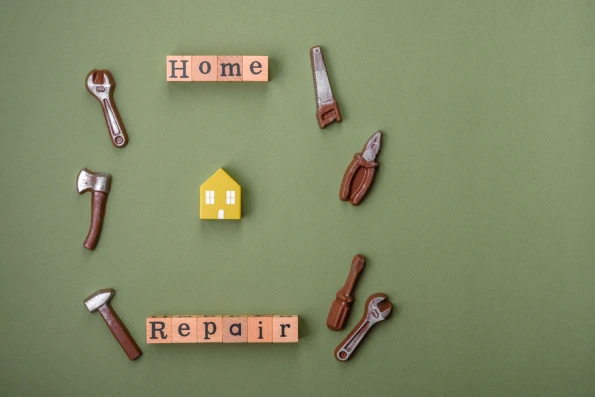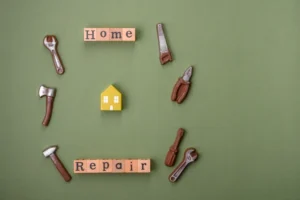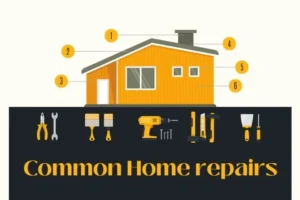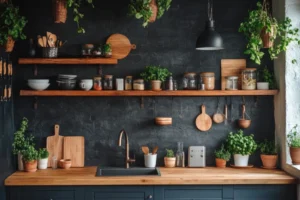Common Home Repairs Every Homeowner Should Know
Owning a home is a joy, but it comes with its fair share of responsibilities. Balancing the financial pressures of homeownership with the skills and knowledge needed for effective DIY home repairs is crucial. No matter how new or well-built your home is, repairs are inevitable. From minor fixes to major issues, home maintenance covers a wide range of tasks.
In this blog, we’ll explore some of the most common home repairs, how to approach them, when to call a specialist, and ways to prevent future issues. Whether you’re a seasoned homeowner or a first-time buyer, this guide will help you keep your home in top shape while saving money and avoiding unnecessary stress.
1. Fixing a Leaky Faucet
A leaky faucet is one of the most common home repairs and also one of the most frustrating. The constant dripping isn’t just an annoyance—it can waste hundreds of gallons of water per year, leading to higher utility bills. Most leaks are caused by a worn washer, damaged O-ring, or faulty seal, making it a relatively easy issue to fix.
DIY Solution
Repairing a leaky faucet is often a straightforward process:
- Turn off the water supply under the sink to prevent flooding.
- Use a wrench or screwdriver to carefully disassemble the faucet.
- Inspect the faucet components for wear or damage, particularly the washer, O-ring, or cartridge.
- Replace the faulty part with a new one, which can be found at most hardware stores.
- Reassemble the faucet and turn the water back on to test for leaks.
When to Call a Professional
If the faucet continues to leak after replacing the parts, or if you’re dealing with a more complex faucet design, it’s best to call a licensed plumber. A professional can ensure the issue is resolved efficiently and prevent further damage to your plumbing system.
Why It’s Important
Fixing a leaky faucet promptly not only helps conserve water but also prevents small plumbing issues from escalating into more significant problems. Over time, even minor leaks can lead to water damage, corrosion, or mold growth.
Preventative Maintenance Tips
- Regularly clean faucet aerators to remove mineral buildup that can cause blockages.
- Inspect faucets periodically for signs of wear, such as reduced water pressure or drips.
- Avoid over-tightening handles, as this can wear out seals more quickly.
By addressing leaks quickly and performing routine maintenance, you can extend the lifespan of your faucets, save money on water bills, and maintain the overall health of your plumbing system.
2. Repairing Drywall Holes
Drywall holes are a common issue in homes, whether caused by hanging artwork, moving furniture, or accidental mishaps. The good news is that drywall repair is one of the easiest and most cost-effective home fixes, and with the right tools, you can restore your walls to their original condition without needing professional help.
Small Holes
For small drywall holes, such as those left behind by nails or screws:
- Apply spackling compound using a putty knife to fill the hole.
- Allow the compound to dry completely (usually a few hours).
- Sand the area smooth using fine-grit sandpaper.
- Repaint the repaired section to match the surrounding wall for a seamless finish.
Larger Holes
For larger holes, such as those caused by accidental impacts:
- Use a drywall patch kit or cut a piece of drywall to fit the hole.
- Secure the patch in place using drywall tape and joint compound.
- Smooth the edges with a putty knife and allow the compound to dry.
- Sand the area smooth, apply additional coats if necessary, and repaint to blend the repair with the rest of the wall.
Why It’s Important
Repairing drywall holes promptly not only saves money but also keeps your walls looking their best. Unrepaired holes can lead to structural damage, moisture issues, or even pest infestations if left unattended.
Pro Tip
After repairing drywall, consider cleaning nearby upholstery to refresh your space. A simple trick is to sprinkle baking soda on furniture, let it sit for 15–20 minutes, and vacuum it off to remove odors and stains effectively.

Preventative Maintenance Tips
- Use adhesive hooks or removable strips for hanging items to minimize damage to drywall.
- Install bumpers or guards on furniture to prevent accidental impacts.
- Regularly inspect walls for signs of wear or damage, especially in high-traffic areas.
By learning how to repair drywall holes, you can save money, improve your home’s appearance, and maintain its value over time. With a little patience and effort, even larger repairs can be tackled successfully.
3. Unclogging Drains
Clogged drains are a common annoyance, whether they occur in the bathroom, kitchen, or laundry room. While a small clog may seem like a minor inconvenience, it can quickly escalate into a more serious plumbing issue if left unaddressed. Learning how to clear a clog effectively can save you time, money, and frustration.
DIY Tools for Minor Clogs
For minor obstructions, you can often resolve the issue with these tools and save a few hundred dollars:
- Plunger: A plunger is a versatile tool for clearing clogs in sinks, tubs, or toilets. Ensure a tight seal and use firm, consistent pressure to dislodge the blockage.
- Drain Snake (or Auger): A drain snake can reach deeper into the pipes to remove hair, grease, or other debris causing the clog. Insert the snake, rotate it, and pull out the obstruction.
For Serious Clogs
If the clog persists after using DIY methods:
- Chemical Drain Cleaners: These can dissolve buildup in the pipes but should be used sparingly. Overuse of harsh chemicals can damage your plumbing or create toxic fumes.
- Call a Professional: For stubborn blockages or recurring clogs, it’s best to contact a licensed plumber. They have specialized tools and expertise to safely and effectively address the issue without harming your pipes.
Why It’s Important
Addressing clogs early ensures your drains remain functional and prevents costly repairs, such as pipe replacements or water damage. Ignoring a clog can lead to slow drainage, standing water, or even sewage backups, which are far more challenging to resolve.
Preventative Maintenance Tips
- Use drain strainers to catch hair, food particles, and debris before they enter the pipes.
- Avoid pouring grease, oil, or coffee grounds down the kitchen sink.
- Regularly flush drains with hot water and a mixture of baking soda and vinegar to prevent buildup.
- Inspect drains periodically for signs of slow drainage or unusual odors.
By taking proactive steps and addressing clogs promptly, you can maintain the health of your plumbing system and avoid costly repairs. Whether it’s a quick DIY fix or a job for a professional, keeping your drains clear is essential for a functional and stress-free home.
4. Replacing Broken Tiles
Broken tiles on your floor or walls are more than just an aesthetic issue—they can pose a safety hazard, especially if the sharp edges are exposed. Replacing damaged tiles is a straightforward process that improves both the look and functionality of your space. With the right tools and techniques, you can restore your tiles to their original condition without needing professional help.
Why Replace Broken Tiles?
- Safety: Cracked or broken tiles can cause injuries, especially in high-traffic areas.
- Prevent Further Damage: Damaged tiles can allow moisture to seep underneath, leading to mold, mildew, or structural damage.
- Aesthetic Appeal: Replacing broken tiles ensures your floors or walls maintain a clean, polished appearance.
Step-by-Step Guide to Replacing a Broken Tile
- Remove the Damaged Tile
- Use a chisel and hammer to carefully break and remove the broken tile. Work slowly to avoid damaging surrounding tiles.
- Scrape away the old adhesive and clean the area thoroughly to create a smooth surface for the new tile.
- Apply Fresh Adhesive
- Spread a thin, even layer of tile adhesive onto the prepared surface using a notched trowel.
- Press the replacement tile firmly into place, ensuring it is level with the surrounding tiles.
- Grout and Seal
- Once the adhesive has dried (usually 24 hours), apply tile grout to fill the gaps around the new tile.
- Wipe away excess grout with a damp sponge and allow it to cure.
- Finish by applying a tile sealant to protect the grout and ensure a long-lasting, polished finish.
Pro Tip
When replacing tiles, keep a few extra tiles from your original project for future repairs. This ensures the replacement matches perfectly in color and texture.
Preventative Maintenance Tips
- Regularly inspect tiles for cracks or chips, especially in high-traffic or moisture-prone areas like bathrooms and kitchens.
- Avoid dropping heavy objects on tiled surfaces to prevent damage.
- Clean tiles and grout regularly to maintain their appearance and prevent buildup.
Don’t Forget About Other Household Repairs
While replacing broken tiles is essential, regular maintenance of other household components, like cabinet doors, is equally important. Addressing common issues like misalignment or squeaky hinges ensures your home remains functional and visually appealing.
By replacing broken tiles promptly and maintaining your home’s surfaces, you can prevent further damage, enhance safety, and keep your space looking its best.
5. Fixing a Running Toilet
A running toilet is more than just an annoyance—it can waste an astonishing amount of water and significantly increase your utility bills. Fortunately, this is one of the most common and manageable plumbing repairs, and most homeowners can tackle it with minimal tools and effort.
Why Fix a Running Toilet Quickly?
- Water Waste: A running toilet can waste hundreds of gallons of water daily, impacting both the environment and your wallet.
- Prevent Bigger Issues: Ignoring the issue can lead to further damage, such as leaks or worn-out components.
- Save Money: Fixing it promptly reduces water bills and avoids costly repairs in the future.
Common Causes of a Running Toilet
- Worn-Out Flapper Valve: The flapper valve controls the flow of water from the tank to the bowl. Over time, it can wear out or fail to seal properly, causing continuous water flow.
- Misaligned or Faulty Float: The float regulates the water level in the tank. If it’s set too high or misaligned, it can cause water to overflow into the bowl.
- Fill Valve Issues: A malfunctioning fill valve may fail to shut off the water supply when the tank is full.
DIY Fix for a Running Toilet
- Inspect the Flapper Valve
- Turn off the water supply to the toilet.
- Remove the tank lid and check the condition of the flapper. If it’s worn or damaged, replace it with a new one from the hardware store.
- Adjust the Float
- If the water level in the tank is too high, adjust the float by bending the rod or turning the adjustment screw on the fill valve.
- Ensure the float is positioned to stop the water flow about 1 inch below the overflow tube.
- Replace the Fill Valve
- If the fill valve is faulty, purchase a replacement kit and follow the instructions to install it. This typically involves removing the old valve, attaching the new one, and reconnecting the water supply.
- Test the Repair
- Turn the water supply back on and flush the toilet to ensure the issue is resolved.
Pro Tip
Keep a toilet repair kit on hand for quick fixes. These kits often include replacement parts like flappers, washers, and fill valves, making repairs even easier.
When to Call a Professional
If the toilet continues to run after trying these fixes, or if you notice leaks or other plumbing issues, it’s best to contact a licensed plumber for a service call to prevent further damage.
By addressing a running toilet promptly, you can save water, reduce frustration, and avoid unnecessary expenses. Regular maintenance of your plumbing system ensures your home remains efficient and functional.
6. Mending Roof Leaks
A leaky roof is a critical issue that can lead to extensive damage if left unaddressed. Water intrusion can harm your ceiling, walls, insulation, and even the structural integrity of your home. Prompt action is essential to prevent costly repairs and maintain a safe, dry living space.
Types of Roof Leaks
- Small Leaks
- Often caused by missing shingles, damaged flashing, or minor wear and tear.
- These are manageable with quick repairs if detected early.
- Large Leaks
- Indicate significant roof damage or structural issues.
- Require professional attention to ensure a thorough and lasting fix.
Steps to Address Roof Leaks
- Identify the Source
- Look for water stains on ceilings, walls, or in the attic.
- Inspect the roof for visible damage, such as cracked shingles, missing tiles, or damaged flashing around vents and chimneys.
- Temporary Fixes for Small Leaks
- Use roofing tape or sealant to patch minor cracks or gaps.
- Replace missing or damaged shingles to prevent further water intrusion.
- Call a Professional for Large Leaks
- Severe leaks often require an expert inspection to assess the damage.
- A licensed roofer can repair or replace sections of the roof to restore its integrity.
Why Address A Leaky Roof Promptly?
- Prevent Costly Repairs: Early intervention stops water damage from spreading to other parts of your home.
- Protect Structural Integrity: Water can weaken wooden supports and lead to mold or mildew growth.
- Maintain Home Value: A well-maintained roof ensures your property remains attractive and valuable.
Pro Tip
Schedule regular roof inspections, especially after extreme weather events like heavy rain, hail, or strong winds. Early detection of potential issues can save you time and money.
7. Repairing Deck Boards
Outdoor decks face constant exposure to harsh weather, heavy foot traffic, and daily wear and tear, making them prone to damage over time. Common issues include loose, cracked, or rotting boards. Addressing these problems promptly ensures safety and extends the life of your deck.
Steps to Repair Deck Boards
- Replace Damaged Boards
- Remove and replace individual boards that are cracked, warped, or rotting.
- Use weather-resistant materials to improve durability.
- Secure Loose Boards
- Tighten screws or nails on loose boards to eliminate hazards.
- Consider using deck screws for a more secure and longer-lasting hold.
Maintenance Tips for Longevity
- Sealing and Staining: Regularly seal and stain your deck to protect it from moisture, UV rays, and general wear.
- Inspect for Damage: Periodically check for signs of decay, splinters, or structural issues to catch anything wrong early.
Proactively maintaining your deck not only enhances its aesthetic appeal but also reduces the need for costly repairs in the future.
8. Fixing Stuck Windows
Windows that won’t open or close properly can be both frustrating and a potential safety hazard, especially during emergencies. This is a common repair issue, particularly in older homes.
Solutions for Stuck Windows
- Simple Fix
- Clean and lubricate window tracks to remove dirt, dust, and debris.
- Use silicone spray or a similar lubricant to ensure smooth operation.
- Addressing Serious Issues
- If the frame is warped or the hardware is damaged, you may need to pay to replace specific parts.
- In severe cases, total window replacement might be necessary.
Additional Maintenance Tips
- Prevent Rust: Use lubricants like silicone or lithium grease on window hinges and door locks to prevent rust and ensure smooth functionality.
- Inspect Regularly: Check windows for cracks, drafts, or signs of wear to address issues before they worsen.
By addressing stuck windows promptly, you can improve your home’s energy efficiency, security, and overall functionality.
9. Replacing Caulk and Sealant
Caulk around tubs, showers, sinks, and windows tends to deteriorate over time. Replacing caulk is one of the most common home repairs that can significantly prevent moisture damage and drafts while improving the appearance of your home.
DIY Process
- Remove Old Caulk: Use a caulk remover tool or utility knife to scrape away the deteriorated caulk.
- Clean the Surface: Ensure the area is dry and free of dirt, mold, or residue.
- Apply Fresh Sealant: Use a caulking gun to apply an even bead of fresh caulk, smoothing it with a finger or caulk tool.
This simple yet impactful repair protects your home from water leaks, prevents mold growth, and gives the area a clean, polished look.
10. Addressing Electrical Outlets
Dead or malfunctioning electrical outlets can be inconvenient and may indicate underlying wiring issues.
DIY Tip
- Reset the breaker in your electrical panel, as tripped breakers are a common cause of inactive outlets.
When to Call a Professional
- If resetting the breaker doesn’t work, or if you notice burn marks, sparks, or loose wiring, contact a licensed electrician.
- Electrical work can be dangerous, so leave complex repairs to professionals to ensure safety and compliance with local codes.
11. Fixing Squeaky Floors
Squeaky floors are often caused by loose subflooring or joists rubbing together.
Quick Fix
- Drive screws into the affected areas to secure the flooring.
- Use special kits designed for squeaky floor repairs if you cannot access the floor from below.
For Multi-Story Homes
- Access the subfloor from below to make repairs more straightforward and effective.
Pro Tip: Warm water can also be used for other home improvement tasks, like cleaning driveways or reactivating wallpaper paste.
12. Cleaning and Maintaining Gutter Systems
Gutters are essential for directing rainwater away from your home’s foundation and preventing water damage.
Regular Cleaning
- Clear leaves, dirt, and debris at least twice a year to maintain proper water flow.
Use Gutter Guards
- Installing guards can reduce the frequency of cleaning and prevent clogs.
Clean gutters not only protect your home but also help avoid moisture-related odors in areas like washing machines.
13. Fixing Fence Panels
Fences enhance privacy, curb appeal, and security, but they’re often damaged by storms or wear over time.
Repair Tips
- Replace broken panels and tighten loose posts to restore stability.
- Stain and seal wooden fences to protect against weather and prolong their lifespan.
A well-maintained fence boosts your property’s appearance and ensures durability during harsh conditions.
14. Foundation Crack Repair
Cracks in your home’s foundation can range from minor cosmetic issues to serious structural concerns.
DIY Solution
- Use sealants or epoxy to fill small cracks and prevent water from seeping in.
For Major Issues
- Consult a professional for advanced solutions, such as foundation piers or slab jacking, to address structural problems.
Regular inspections can help identify and address minor issues before they escalate into costly repairs.
15. Garage Door Repairs
Garage doors are heavily used and prone to issues like damaged springs, misaligned tracks, or busted rollers.
DIY Maintenance
- Lubricate tracks and hinges to ensure smooth operation.
- Replace remote batteries and inspect for minor wear.
Professional Repairs
- For broken springs or misaligned tracks, hire a professional to ensure safety and proper functioning.
Routine maintenance can help avoid expensive garage door repairs and extend its lifespan.
16. Siding Repairs
Damaged siding not only affects your home’s appearance but can also allow water leaks and pest intrusion.
Vinyl Siding
- Use repair kits from hardware stores to replace damaged sections easily.
Wood Siding
- Repairs may require more expertise but can be done with the right tools and materials.
Regular inspections, gutter cleaning, and prompt repairs keep your siding in good condition and maintain your home’s curb appeal.
Final Thoughts
Home repairs may seem daunting, but many common issues can be tackled with a little knowledge and effort. Knowing when to DIY and when to call a professional is key to keeping your home in great shape while saving money in the long run.
By staying proactive and performing regular maintenance, you can prevent small problems from becoming major headaches. After all, a well-maintained home is a happy home!
Frequently Asked Questions (FAQs)
1. What are the signs that my water heater needs repair?
Uneven water temperature, popping or rumbling sounds, rusty water, and pooling around the tank are clear indicators. Addressing these issues early can prevent costly water damage or full replacements.
2. What should I do if my circuit breaker keeps tripping?
Frequent tripping may indicate electrical issues, such as overloaded circuits, damaged appliances, or faulty wiring. Try unplugging non-essential devices and resetting the breaker. If the problem persists, contact a licensed electrician for professional electrical work.
3. What should I do if I smell gas in my house?
Leave immediately without using lights, electronics, or anything that could cause a spark. Once outside, call your gas provider’s emergency line or the fire department. Never attempt to locate or fix a gas leak yourself.
4. How do I remove water stains from ceilings or walls?
First, fix the source of the leak to prevent further damage. Clean the stain with a mixture of bleach and warm water, then let it dry completely. Apply a stain-blocking primer before repainting to ensure the stain doesn’t reappear.
5. What are the signs of structural issues in a home?
Look for sticking doors or windows, sloping floors, large cracks in walls, and bowing or sagging ceilings. These signs may indicate serious foundation problems. Contact a structural specialist to inspect and address potential issues.
6. How can I keep pests out of my house?
To prevent infestations:
- Seal cracks around windows and doors, walls, and foundations.
- Store food in airtight containers.
- Fix leaks to eliminate moisture sources.
- Clean spills immediately and ensure regular cleaning throughout the home.
7. What are the signs of septic system problems?
Common signs include:
- Slow drains or frequent clogs.
- Gurgling pipes.
- Foul odors near the tank or drain field.
- Extra-green grass or pooling water near the septic system.
Call a septic professional if any of these issues arise to avoid costly repairs.
8. How can I prevent ice dams in winter?
To prevent roof leaks caused by ice dams:
- Ensure proper attic insulation and ventilation.
- Clean clogged gutters before winter to allow water to flow freely.
- Use heated roof cables in problem areas to melt ice buildup.
Call to Action
Feeling overwhelmed with home repairs? Let Steadfast Construction WI take the stress out of your hands. Our experienced team delivers reliable, high-quality repair and construction services tailored to your needs.
🔗 Visit us at Steadfast Construction WI to explore our services or schedule a consultation. Follow us on Facebook for tips, updates, and home improvement inspiration.
Let us get the job done right the first time!
















